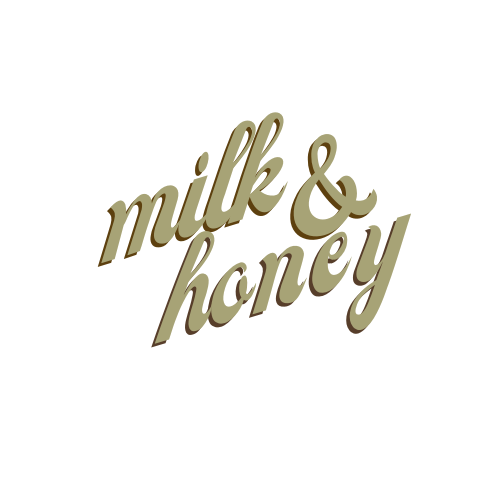
Why Milk Type Matters: How Oat, Almond, and Dairy Change Coffee Flavor
Share
TLDR;
The milk you choose changes how your coffee tastes, feels, and froths. Dairy milk delivers a classic, creamy sweetness. Oat milk adds a smooth, slightly sweet texture. Almond milk brings a light, nutty flavor. Each milk interacts with coffee differently, shaping the final cup.
Why Milk Type Matters in Coffee

Milk affects coffee flavor by changing sweetness, acidity, and mouthfeel. It determines whether your cappuccino feels rich and velvety or light and nutty. The milk type you choose also affects frothing, latte art, and even how the coffee finishes on your palate.
At Milk & Honey Coffee Co., we focus on milk choice because it defines how each espresso or pour-over expresses itself. Fat, protein, and carbohydrates inside milk interact with the coffee’s oils and acids. These interactions decide how the drink tastes.
Understanding Milk and Coffee Interaction

Milk adds balance to coffee. It reduces bitterness and enhances natural sweetness. The fat content provides a creamy mouthfeel, while proteins help stabilize foam. Carbohydrates bring natural sugars that complement the coffee’s roasted flavor.
Key roles of milk components in coffee:
-
Fat: Adds smooth texture and body. Higher fat means richer flavor.
-
Protein: Supports microfoam stability when steaming.
-
Carbohydrates: Provide mild sweetness that rounds out acidity.
A well-balanced cup depends on how these elements mix with the coffee bean’s flavor. For example:
-
A dark roast with whole milk feels chocolatey and full.
-
A light roast with oat milk keeps the coffee bright but creamy.
The right milk doesn’t overpower the coffee but complements it.
How Milk Alters Coffee Flavor Profiles

Milk tones down acidity, adds sweetness, and changes mouthfeel. Each milk type influences the flavor balance differently:
-
Dairy milk softens bitterness and deepens body.
-
Oat milk maintains natural sweetness with mild grain flavor.
-
Almond milk enhances nutty notes but can make coffee taste thinner.
When steamed, milk proteins unfold and create microfoam. This foam traps air, building texture. Barista-edition plant milks are formulated for this reason—they contain stabilizers to mimic dairy’s performance.
Frothing and Texture: Why Some Milks Steam Better

Not every milk performs equally under heat. Frothing success depends on protein stability and fat balance.
-
Whole dairy milk steams evenly, creating fine foam for latte art.
-
Oat milk (barista edition) mimics dairy well, producing stable foam with soft sweetness.
-
Almond milk tends to separate when overheated, leading to curdling.
Tips for better froth:
-
Steam below boiling to avoid curdling.
-
Use barista-edition plant milks for consistent texture.
-
Always swirl steamed milk before pouring to mix foam and liquid evenly.
Dairy Milk: The Traditional Benchmark

Dairy milk remains the gold standard in coffee preparation. Its protein and fat create natural sweetness and perfect foam.
Types of dairy milk and their qualities:
-
Whole milk: Richest and creamiest. Balances acidity perfectly.
-
2% milk: Slightly lighter body but still smooth.
-
Skim milk: Less creamy, sharper flavor, froths quickly but lacks depth.
Advantages of dairy milk:
-
Balanced flavor with natural lactose sweetness.
-
Consistent texture ideal for espresso-based drinks.
-
Performs best in latte art due to protein and fat synergy.
Disadvantages:
-
Unsuitable for lactose-intolerant or vegan customers.
-
Higher environmental impact compared to plant milks.
At Milk & Honey Coffee Co., dairy milk is preferred for traditional lattes and cappuccinos when customers want the classic café experience.
Oat Milk: The Creamy Plant-Based Challenger

Oat milk offers the closest match to dairy in texture. It’s made by blending oats and water, then filtering to create a smooth liquid.
Flavor profile:
-
Mild, slightly sweet, often with a natural vanilla note.
-
Creamier than almond milk due to higher carbohydrate content.
-
Complements both dark and medium roasts without overpowering them.
Why oat milk works well for coffee:
-
Excellent microfoam stability for lattes and cappuccinos.
-
Neutral flavor that supports the coffee’s characteristics.
-
Works well with iced and hot drinks.
Potential drawbacks:
-
Higher carbohydrates than almond milk.
-
Some brands differ in consistency and sweetness.
For café use, barista-edition oat milk ensures better steaming performance. It creates silky foam with soft sweetness, ideal for latte art.
Almond Milk: The Light Nutty Alternative

Almond milk adds a unique nutty twist to coffee. It’s lighter, thinner, and less sweet than oat or dairy milk.
Flavor and texture:
-
Brings a toasted almond note to espresso.
-
Works well in cold coffee or flavored drinks.
-
Can taste bitter if overheated.
Best uses:
-
Cold brews or iced lattes where separation is less likely.
-
Medium roast coffee with nutty or chocolate notes.
Limitations:
-
Lower protein content leads to weaker froth.
-
May curdle when combined with acidic espresso if not steamed properly.
At Milk & Honey Coffee Co., almond milk is often chosen by customers who want a light, plant-based option with distinct nutty flavor.
Oat, Almond, and Dairy Milk Comparison
|
Feature |
Dairy Milk |
Oat Milk |
Almond Milk |
|
Flavor |
Creamy, slightly sweet |
Mild, smooth, slightly sweet |
Nutty, light, sometimes bitter |
|
Texture |
Thick, rich, velvety |
Creamy, consistent |
Thin, light |
|
Frothing Performance |
Excellent |
Good (Barista edition best) |
Weak to moderate |
|
Best For |
Lattes, cappuccinos, flat whites |
Lattes, iced drinks |
Iced coffee, cold brew |
|
Dietary Fit |
Contains lactose |
Vegan |
Vegan |
|
Environmental Impact |
High |
Low to moderate |
Moderate to high water use |
Choosing the Right Milk for Your Coffee Style

Each coffee style benefits from a different milk base.
-
Espresso or flat white: Dairy or oat milk for balance and body.
-
Cappuccino: Whole milk or barista-edition oat milk for microfoam.
-
Cold brew: Almond milk for light, nutty refreshment.
-
Iced latte: Oat milk for smooth consistency.
Practical tips:
-
Use chilled milk for better steaming.
-
Avoid overfilling the pitcher to maintain foam control.
-
For vegan drinks, choose plant milks labeled “barista edition” for stable texture.
Flavor Pairings and Bean Types

The coffee bean’s roast level affects how milk interacts with it.
-
Light roast: Pair with oat milk to keep fruity acidity balanced.
-
Medium roast: Works well with almond milk to highlight nutty tones.
-
Dark roast: Complements whole dairy milk for rich, chocolatey depth.
Recommended pairings from Milk & Honey Coffee Co.:
-
Colombian beans with oat milk for caramel-sweet balance.
-
Ethiopian beans with dairy milk to soften acidity.
-
Brazilian beans with almond milk to emphasize chocolate notes.
The goal is harmony between the milk’s texture and the coffee’s profile.
Plant-Based Milk vs Dairy in Coffee

Plant-based milks change the coffee experience. They offer dietary flexibility and environmental benefits but vary in taste and froth.
Pros of plant-based options:
-
Suitable for lactose intolerance and vegan diets.
-
Often lower in saturated fat.
-
Sustainable compared to dairy production.
Cons:
-
Some separate in espresso-based drinks.
-
Inconsistent flavor across brands.
-
Lower protein levels affect foam quality.
When comparing oat vs almond vs dairy, no single option is “best.” The ideal choice depends on preference, dietary goals, and flavor expectations.
Sustainability and Health Factors

Environmental impact and nutrition influence milk choice as much as flavor.
-
Dairy milk: Higher carbon footprint and water use. Provides protein, calcium, and fat.
-
Oat milk: Sustainable and low-impact. Slightly higher in carbs.
-
Almond milk: Uses less land but more water during farming. Low in calories and protein.
For customers watching sugar intake or managing diabetes, exploring Diabetes-friendly coffee creamer options can provide a balanced, health-conscious alternative.
For customers who prioritize taste and sustainability, oat milk offers the most balanced option.
Future Trends in Coffee Milk Alternatives

Baristas and roasters continue experimenting with new blends of plant-based milks designed for coffee. Expect growth in pea, soy, and hybrid oat-almond milks formulated for frothing and flavor retention.
At Milk & Honey Coffee Co., we see plant-based milks improving rapidly. New barista formulations now rival dairy for foam and texture. As consumers focus on sustainability and health, demand for these alternatives will continue to rise.
Why Milk Type Matters Coffee: Final Thoughts

Milk changes everything about your coffee experience. From flavor to texture, each milk brings a different personality to your cup.
-
Dairy milk delivers the traditional, creamy café taste.
-
Oat milk offers balance and smooth sweetness for plant-based drinkers.
-
Almond milk gives a nutty, lighter finish perfect for cold drinks.
Choosing the right milk is about matching flavor, texture, and purpose. Try each one with your favorite roast and brewing style. You’ll find the combination that makes your daily coffee stand out—crafted to perfection at Milk & Honey Coffee Co.
